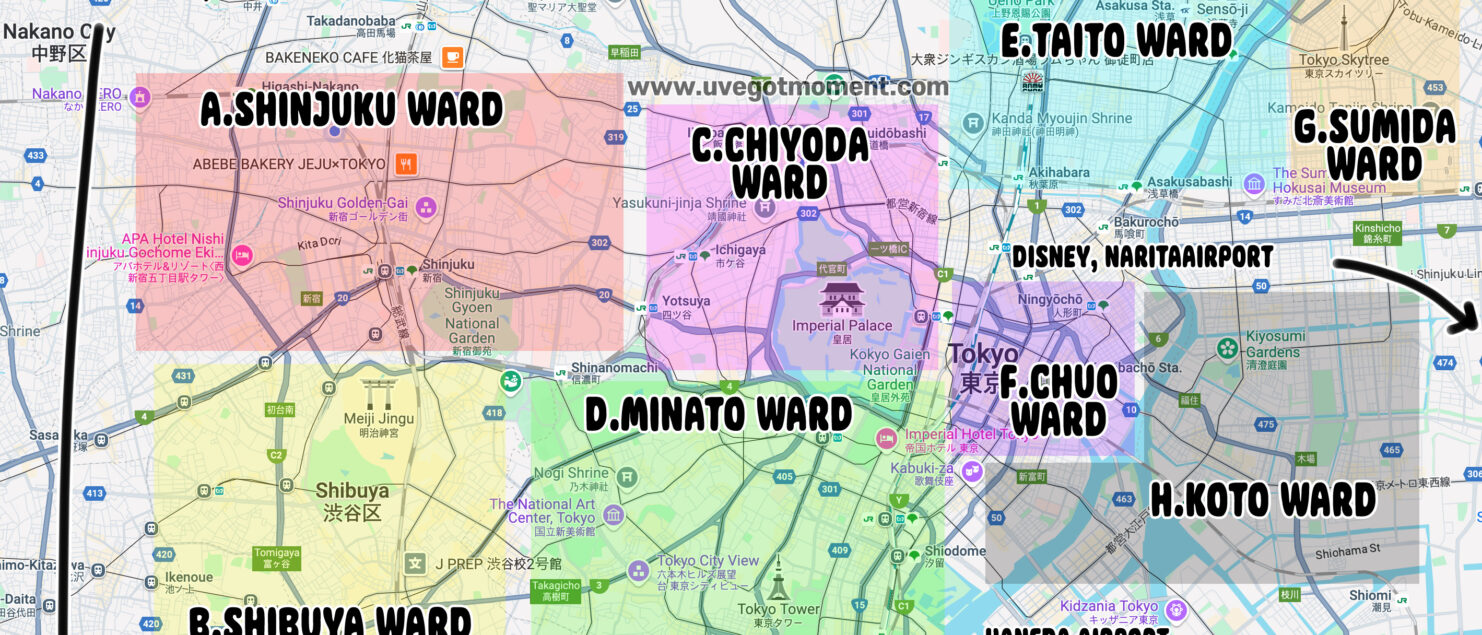Tokyo Travel Simple Guide: A District-by-District Overview
Before We Dive In
While planning a trip abroad (other than Japan), I found myself looking up accommodations and destinations. Many of the names and places were unfamiliar, making it hard to grasp the bigger picture. So, I turned to foreign blogs and mapped out each location one by one, slowly piecing it all together.
This experience reminded me that many first-time travelers to Tokyo might face a similar struggle. They often lack a clear understanding of neighborhoods and districts, which can make travel planning challenging. I’ve even had photography clients ask if Shibuya and Asakusa could be visited together (it’s very far!)
Most blog posts and YouTube videos focus on specific areas rather than providing a general overview, which can leave travelers feeling overwhelmed (personal opinion!).
From my own experience, I’ve realized that having a general sense of each area and its geographical position makes travel much easier. So, I’ve decided to create a guide to help others navigate Tokyo more smoothly.
Tokyo’s First-Time Travelers: A District-by-District Overview
This post is geared toward those visiting Tokyo for the first time or those who haven’t been here often. It highlights the most popular and frequently visited spots. (Seasoned visitors probably prefer hidden gems and local hangouts rather than these famous tourist spots! 😅)
For those still struggling to grasp Tokyo’s layout, I’ve categorized and mapped out the districts and included a handy table for reference.
Note: These are approximate boundaries, and slight inaccuracies may occur in the drawn map.
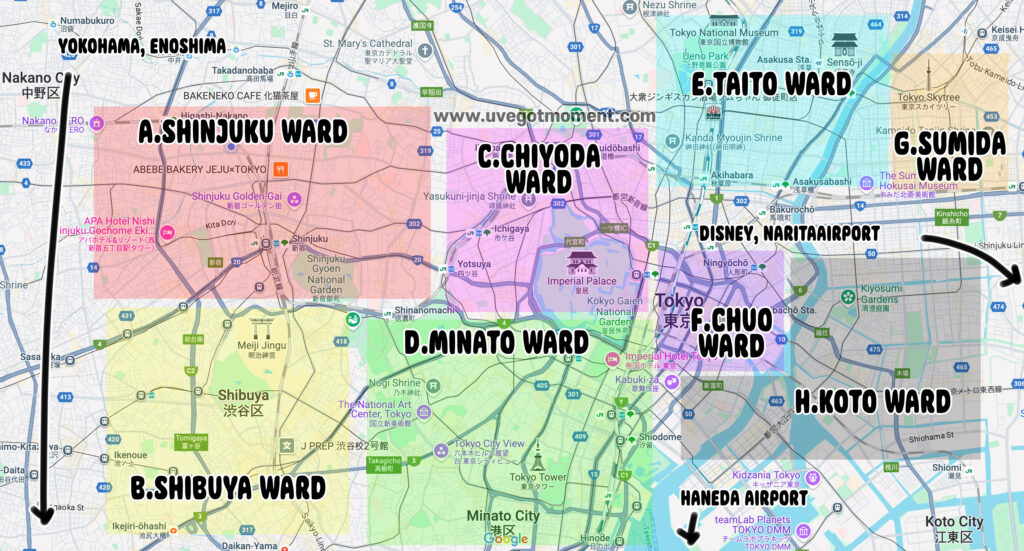
Districts Overview
| District | Key Areas/Landmarks | Vibes/Keywords | Personal Comments |
|---|---|---|---|
| A. Shinjuku | Shinjuku, Shinjuku Gyoen, Nakano, Kabukicho, Tokyo Metropolitan Government Building, Express Bus Terminal | Busy, lively, bars, izakayas, budget-friendly accommodations, convenient for travel (Hakone, Kamakura, etc.), popular among 20s-30s | Ideal for young travelers on a budget. Shinjuku offers affordable stays and great transport links. |
| B. Shibuya | Shibuya (Scramble Crossing), Shibuya Sky, Yoyogi Park, Omotesando, Meiji Shrine, Harajuku, Nakameguro, Daikanyama, Ebisu | Shopping, cafes, a mix of high-end and mid-range options, youthful vibe, Hongdae-like atmosphere | Shibuya has plenty to explore, making it a great base for your trip. |
| C. Chiyoda | Imperial Palace, Akihabara, Budokan | Central Tokyo, otaku culture, electronics, anime goods | Akihabara is a haven for anime enthusiasts and tech shoppers. Don’t miss the nearby Imperial Palace for a peaceful stroll. |
| D. Minato | Roppongi, Tokyo Tower | Upscale dining, nightlife, shopping, luxury hotels | Perfect for travelers seeking a luxurious experience. Stay in Roppongi if budget permits. |
| E. Taito | Asakusa, Ueno, Nippori (Yanaka Ginza) | Retro vibes, traditional markets, izakayas, reminiscent of Jongno/Euljiro in Seoul | Great for those who enjoy nostalgic, local vibes. Avoid if you dislike crowds or slightly messy environments. |
| F. Chuo | Tokyo Station, Ginza, Tsukiji Market | Luxury shopping, skyscraper vibes, transport hub | Ideal for brand shopping and experiencing Tokyo’s urban elegance. |
| G. Sumida | Skytree | Tokyo Skytree-centric, limited attractions | Mostly known for Skytree. Popular for cherry blossoms along Sumida River in spring. |
| H. Koto | Kiyosumi Shirakawa (Modern Art Museum), Odaiba, teamLab | Spacious, modern art, teamLab exhibitions | Perfect for art enthusiasts and those visiting teamLab exhibitions. Odaiba offers a unique, futuristic vibe. |
In-Depth Look at Key Districts
A. Shinjuku (新宿)
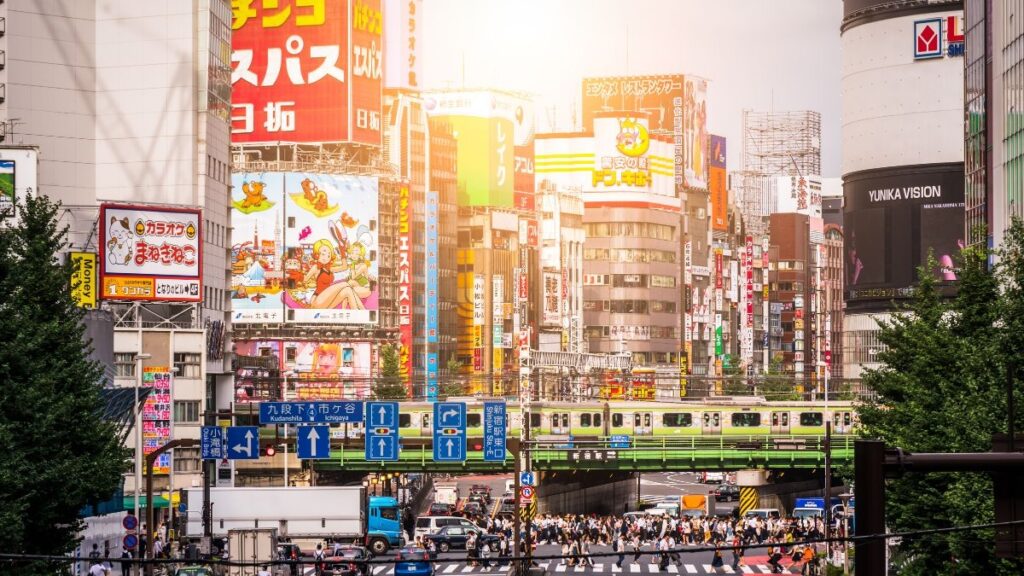
Key Features: Shinjuku is one of Tokyo’s most iconic and bustling areas, along with Shibuya. It serves as a major transportation hub with express bus terminals and trains that directly connect to Narita Airport via the Narita Express. Trains to Hakone, Kamakura, and Enoshima also depart from Shinjuku, making it an excellent base for day trips. Additionally, express trains to Yokohama are available, highlighting the district’s transportation advantages.
East vs. West Shinjuku:
The eastern side is famous for its nightlife, with a wide range of izakayas, bars, and entertainment options like Kabukicho. Kabukicho is well-known among locals for its vibrant bar scene, small yakitori alleys (e.g., Omoide Yokocho), and even host clubs. The western side, in contrast, features a more business-like atmosphere with high-rise office buildings and the Tokyo Metropolitan Government Building, which offers a free observation deck. However, due to COVID-19, it’s best to check its operation status before visiting.
Safety Tips:
While Shinjuku is generally safe, female travelers staying alone or exploring late at night should be cautious, especially in East Shinjuku. The area can be crowded with intoxicated people, and there are instances of aggressive touting or unsolicited attention.
Shinjuku Gyoen:
This park is a famous cherry blossom viewing spot and is well-maintained with an affordable entrance fee. It’s not particularly unique, but it’s a great spot for a picnic or a leisurely stroll, especially if traveling with kids. (Note: Alcohol is prohibited in the park.)
(More detailed Shinjuku breakdown available in my previous post: “Shinjuku Overview and Area Guide.”)
You can check some photoshoot session taken in Shinjuku area → Click here!
B. Shibuya (渋谷)
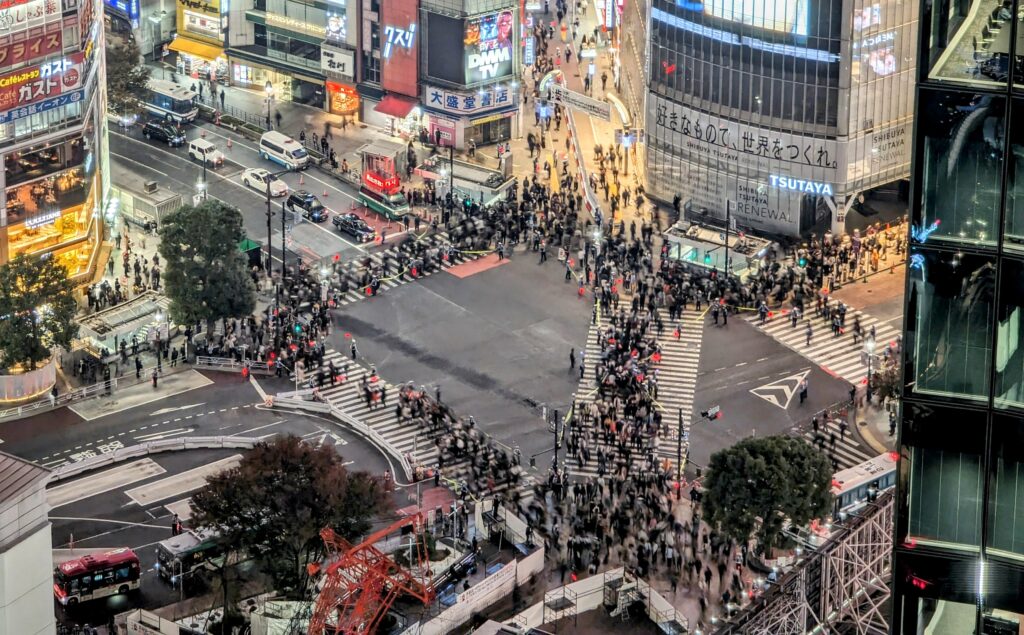
Key Features: Shibuya is globally recognized for its Scramble Crossing and the Hachiko Statue. The crossing is one of the busiest pedestrian intersections in the world and a must-see for visitors.
Shopping & Neighborhoods:
Shibuya isn’t limited to its famous crossing. Harajuku and Omotesando are nearby and easily walkable. Harajuku is popular among younger crowds for its quirky, vibrant shops selling vintage fashion, streetwear, and unique desserts. On the other hand, Omotesando caters to an older demographic with high-end brand boutiques like Comme des Garçons.
Shibuya Sky:
This observation deck is one of the city’s most popular attractions. Located near Shibuya Station, it offers panoramic views of the city. Tickets for sunset slots sell out quickly, so it’s recommended to book in advance. Be cautious, as tickets are non-refundable.
Peaceful Alternatives:
Nakameguro, a quieter area along the Meguro River, is perfect for cafes and boutique shopping. During the cherry blossom season, however, the area gets crowded with visitors. Daikanyama is another calm and trendy spot nearby, great for a leisurely day.
(Tip: If you’re feeling ambitious, you can walk from Shibuya to Nakameguro, Daikanyama, and even Ebisu.)
You can check some photoshoot session taken in Shibuya area → Click here!
C. Chiyoda (千代田)
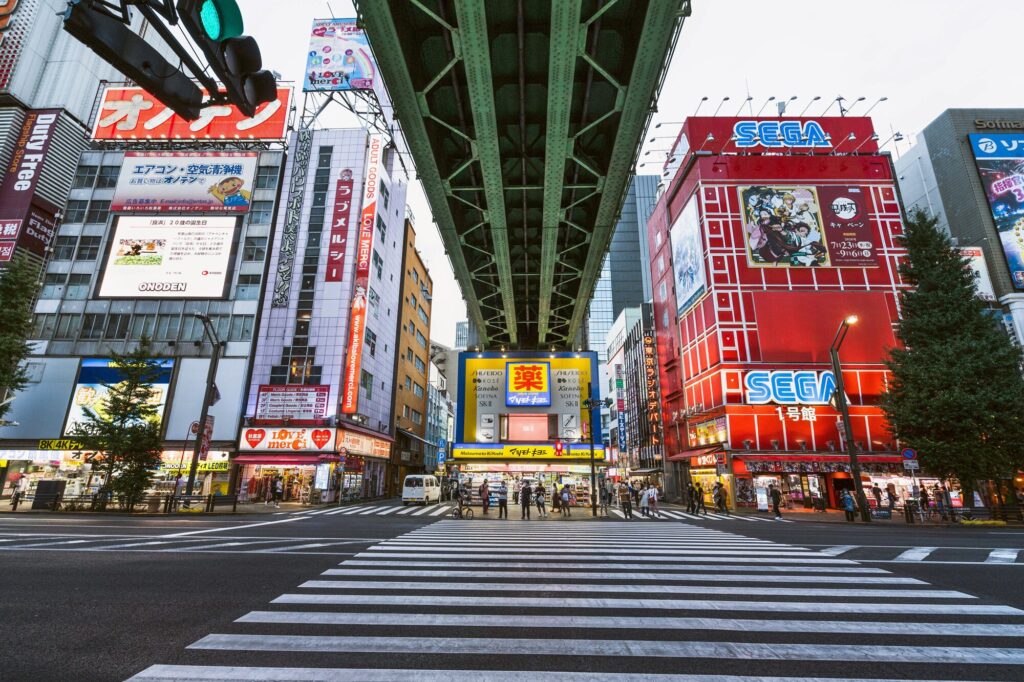
Key Features: Chiyoda is located at the heart of Tokyo, with iconic landmarks like the Imperial Palace, Akihabara, and Nippon Budokan. Tokyo Station is also situated here, making it a central transportation hub for Shinkansen lines heading to Osaka and other destinations.
Imperial Palace:
Situated in a vast green space, it’s great for a leisurely stroll. However, its proximity to Yasukuni Shrine might make some visitors hesitant.
Akihabara:
This neighborhood is a paradise for anime and otaku culture enthusiasts, offering everything from figurines and electronics to secondhand goods. The area also features maid cafes, popularized internationally by content creators.
(Personal Tip: Even if you’re not into anime or tech, Akihabara offers a unique cultural experience that’s worth a visit.)
D. Minato (港区)
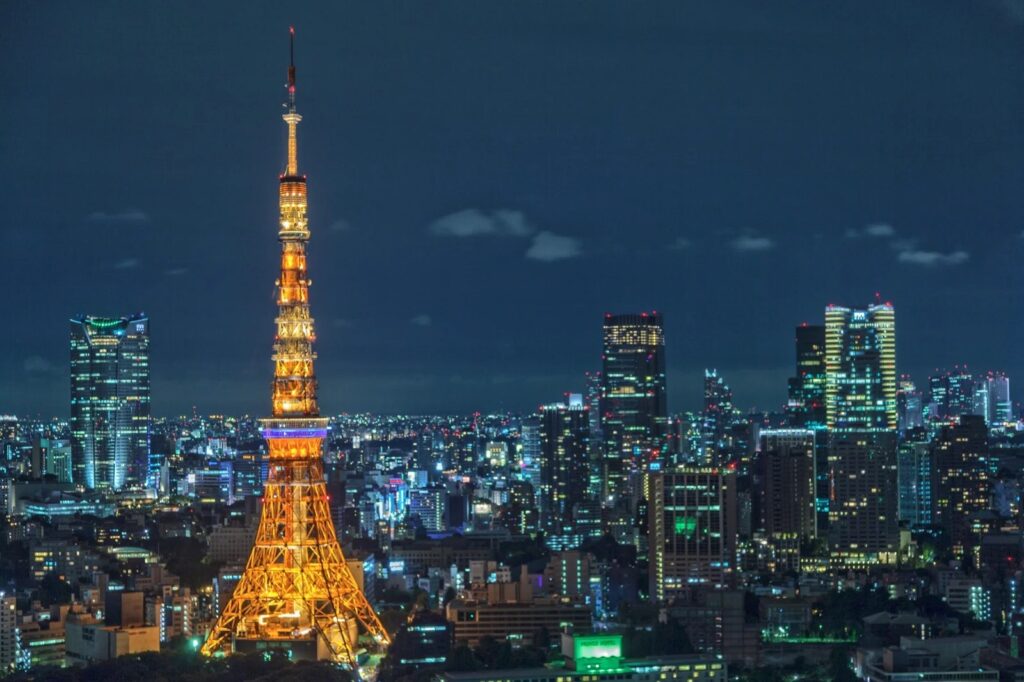
Key Features: Known for its upscale vibe, Minato is home to Roppongi and Tokyo Tower. The district boasts luxury hotels, fine dining, and high-end shopping options.
Roppongi:
Popular among international tourists, Roppongi offers a mix of nightlife and cultural experiences. Mori Tower’s observation deck provides close-up views of Tokyo Tower. However, Roppongi’s nightlife can feel a bit intense, with touts often targeting visitors.
Tokyo Tower:
A symbol of Tokyo, Tokyo Tower is a short walk from Roppongi. Nearby, Azabu-Juban offers a charming atmosphere with a mix of international dining options and local shops.
You can check some photoshoot session taken in Tokyo Tower area → Click here!
E. Taito (台東区)
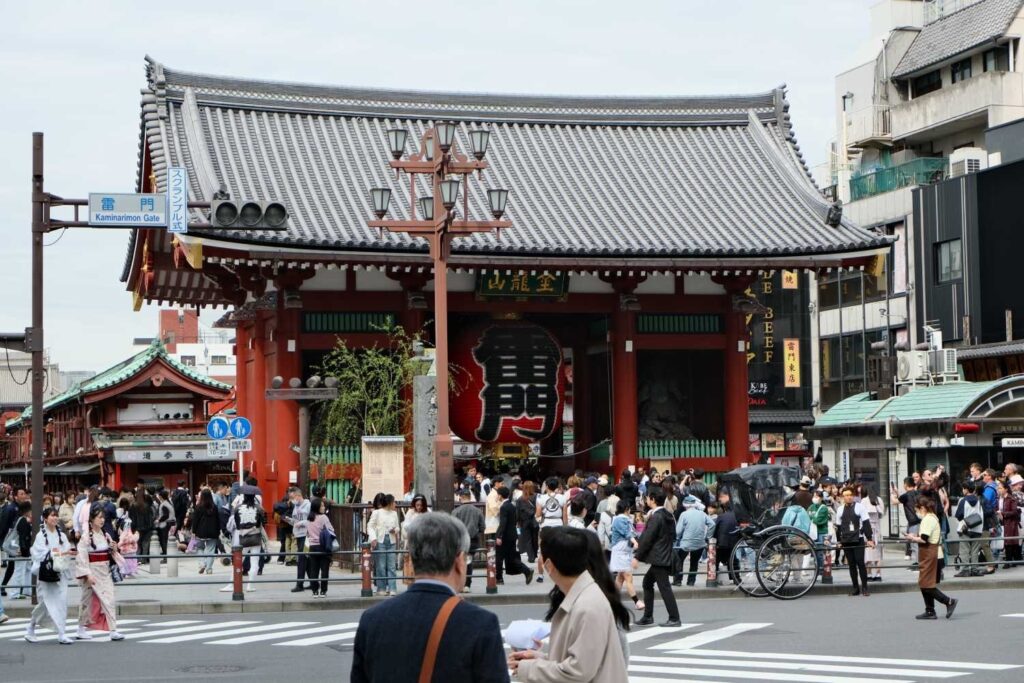
Key Features: Taito retains much of Tokyo’s old-world charm and is perfect for those seeking a retro experience.
Asakusa:
A historic area featuring Kaminarimon Gate and Senso-ji Temple. Behind the temple, Hoppy Street is lined with izakayas offering a glimpse into local drinking culture. The area is popular among older locals, adding to its nostalgic vibe.
Ueno:
Just a few stations away, Ueno offers the Ameya-Yokocho market, reminiscent of Korea’s Namdaemun or International Markets. Ueno Park, one of Tokyo’s largest green spaces, features a zoo, museums, and is a prime cherry blossom viewing spot.
(Note: The retro vibe may not appeal to everyone. Visitors preferring a cleaner or more modern environment may want to explore other districts.)
F. Chuo (中央区)
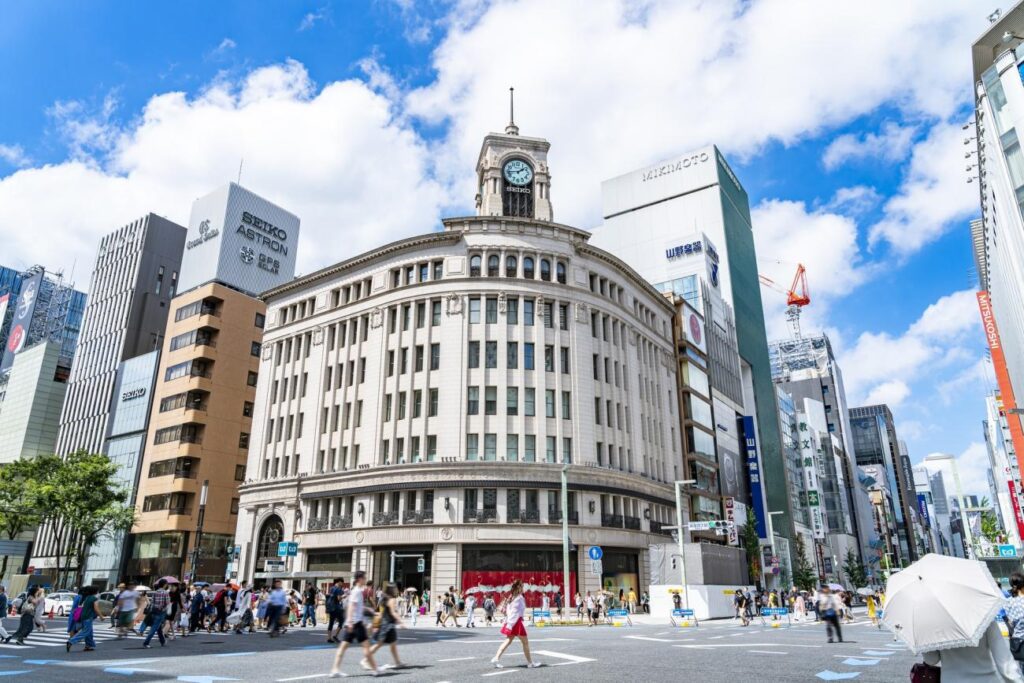
Key Features: Chuo is Tokyo’s commercial hub, famous for Ginza’s luxury shopping streets and Tsukiji Market’s fresh seafood.
Ginza:
Known for high-end brands like Gucci and Louis Vuitton, Ginza offers a sophisticated shopping experience. However, its dining options can be expensive, and casual eateries are limited.
Tsukiji Market:
A short distance from Ginza, Tsukiji remains a must-visit for its seafood and street food offerings.
(Tip: While Ginza is ideal for luxury shoppers, travelers on a budget might find it less appealing.)
G. Sumida (墨田区)
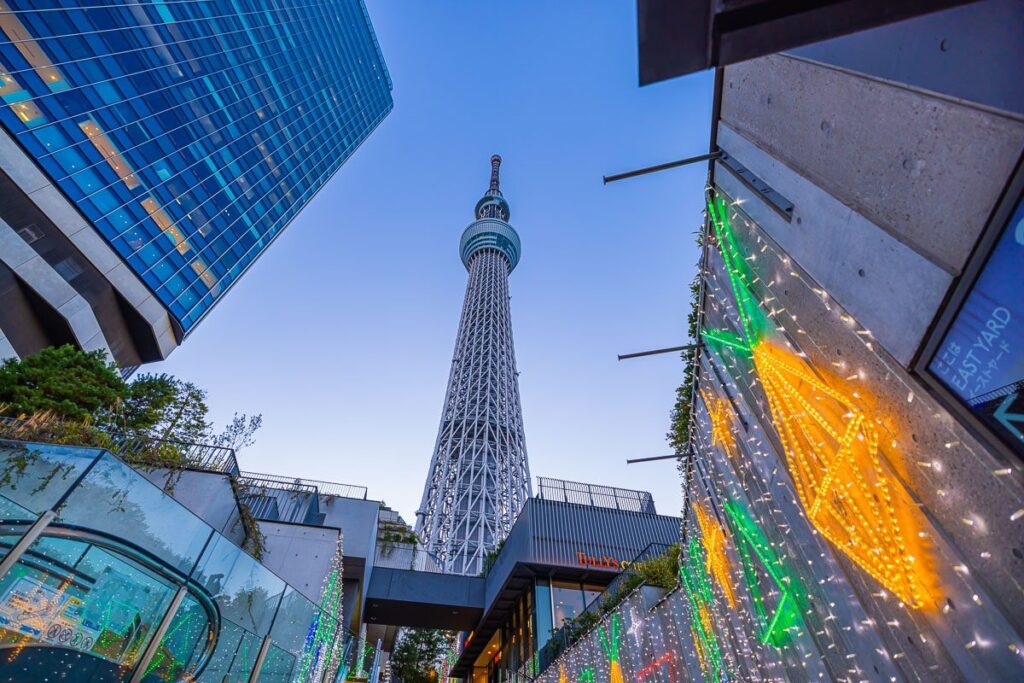
Key Features: Sumida is primarily known for the Tokyo Skytree, Japan’s tallest structure.
Seasonal Events:
In spring, the Sumida River area becomes a cherry blossom hotspot, while summer brings fireworks festivals.
(Beyond Skytree, Sumida offers limited attractions, so plan your visit accordingly.)
H. Koto (江東区)
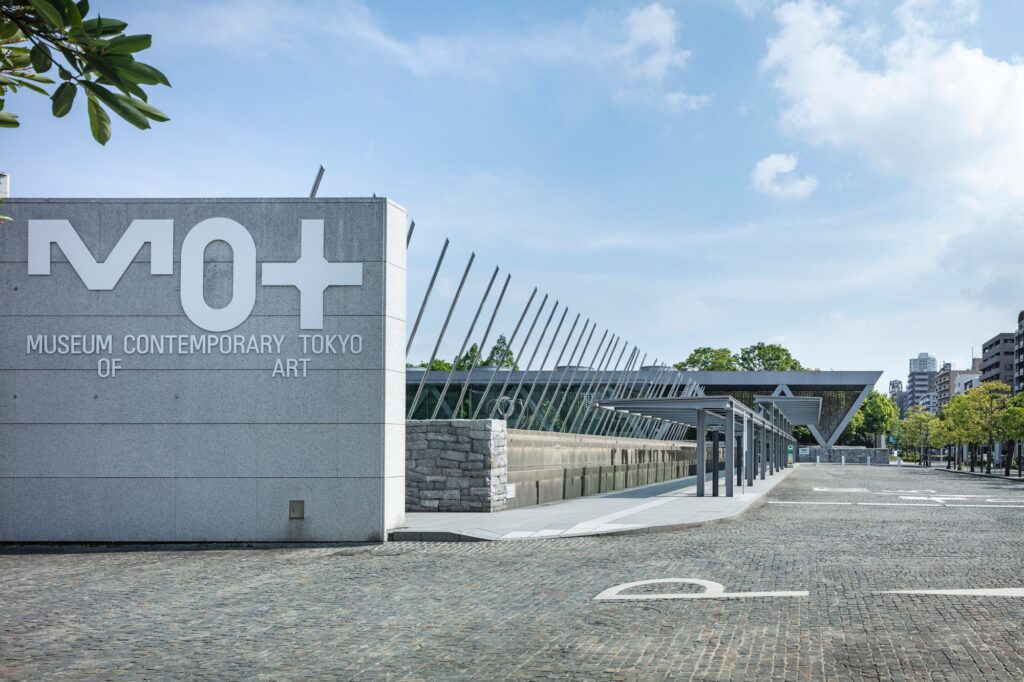
Key Features: Koto is home to Odaiba and TeamLab, making it a favorite among those seeking a futuristic experience.
Odaiba:
Once a landfill, Odaiba now features attractions like the Rainbow Bridge. While some facilities have closed post-COVID, TeamLab exhibitions remain a popular draw.
Kiyosumi-Shirakawa:
This area offers a mix of modern art museums and quiet cafes, including Japan’s first Blue Bottle Coffee shop.
(Tip: Even if you’re not attending a TeamLab exhibition, Odaiba is worth a visit for its waterfront views and unique atmosphere.)

